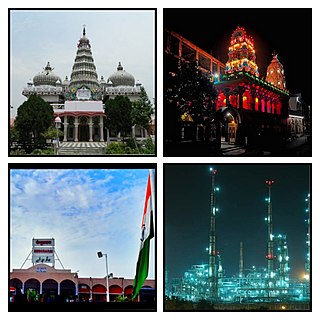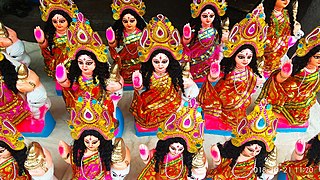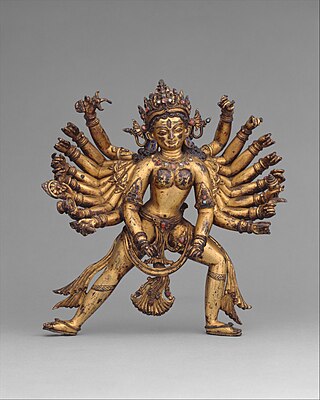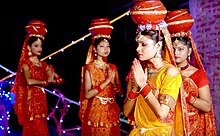
Rangda is the demon queen of the Leyaks in Bali, according to traditional Balinese mythology. Terrifying to behold, the child-eating Rangda leads an army of evil witches against the leader of the forces of good — Barong. The battle between Barong and Rangda is featured in a Barong dance which represents the eternal battle between good and evil.

Goramansingh also known as Gauramansingh is a small village in the Darbhanga district of Bihar, India. It is located approximately 62 kilometers east of Darbhanga and 12 kilometers east from its subdivisional headquarters of Biraul on the bank of the Kamala River in Bihar.

Begusarai is the industrial and financial capital of Bihar and the administrative headquarters of the Begusarai district, which is one of the 38 districts of the Indian state of Bihar. The district lies on the northern bank of the river Ganges in the Mithila region of India.

Sharad Purnima is a religious festival celebrated on the full moon day of the Hindu lunar month of Ashvin, marking the end of the monsoon season. The full moon night is celebrated in different ways in various cultural regions across Indian subcontinent.

Dashain or Bada'dashain, also referred as Vijaya Dashami in Sanskrit, is a major Hindu religious festival in Nepal and the Indian states of Sikkim, West Bengal, Assam, South India, and Sri Lanka. It is also celebrated by other religions of Nepal and elsewhere in the world, including among the Lhotshampa of Bhutan and the Burmese Gurkhas of Myanmar. The festival is also referred as Nauratha, derived from the Sanskrit word for the same festival Navaratri which translates to Nine Nights.

Maithils, also known as Maithili people, are an Indo-Aryan cultural and ethno-linguistic group from the Indian subcontinent, who speak the Maithili language as their native language. They inhabit the Mithila region, which comprises Northern and Eastern Bihar and Northeastern Jharkhand in India & in Nepal constituting Madhesh Province in addition to some terai districts of Bagmati and Koshi Provinces.

Mithila, also known as Tirhut, Tirabhukti and Mithilanchal, is a geographical and cultural region of the Indian subcontinent bounded by the Mahananda River in the east, the Ganges in the south, the Gandaki River in the west and by the foothills of the Himalayas in the north. It comprises certain parts of Bihar and Jharkhand of India and adjoining districts of the Koshi Province, Bagmati Pradesh and Madhesh Province of Nepal. The native language in Mithila is Maithili, and its speakers are referred to as Maithils.

Duhabi is a Village Development Committee in Dhanusa District in the Janakpur Zone of south-eastern Nepal. At the time of the 1991 Nepal census it had a population of 5,762 persons residing in 990 individual households.

Mithila culture or Maithil culture refers to the culture which originated in the Mithila region of the Indian subcontinent. Mithila comprises Tirhut, Darbhanga, Kosi, Purnia, Munger, Bhagalpur and Santhal Pargana divisions of India and adjoining provinces of Province No. 1, Bagmati Pradesh, and Madhesh Province of Nepal.
Bihari culture refers to the culture of the Indian state of Bihar. Bihari culture includes Angika culture, Mithila culture, Bhojpuri Culture and the culture of Magadha.

Shashthi, Shashti, Soshthi or Chhathi (Sanskrit: षष्ठी, Bengali: ষষ্ঠী, Hindi: छठी, Ṣaṣṭhī, literally "sixth") is a Hindu goddess, venerated in Nepal and India as the benefactor and protector of children. She is also the deity of vegetation and reproduction and is believed to bestow children and assist during childbirth. She is often pictured as a motherly figure, riding a cat and nursing one or more infants. She is symbolically represented in a variety of forms, including an earthenware pitcher, a banyan tree or part of it or a red stone beneath such a tree; outdoor spaces termed Shashthi Tala are also consecrated for her worship. The worship of Shashthi is prescribed to occur on the sixth day of each lunar month of the Hindu calendar as well as on the sixth day after a child's birth. Barren women desiring to conceive and mothers seeking to ensure the protection of their children will worship Shashthi and request her blessings and aid. She is especially venerated in eastern India.

Chinnamasta Bhagawati also called Shakhada Bhagawati and Shakhadeswori is a temple and Shakti Peetha in Eastern Nepal. It was established in the 13th century by Shaktisimhadeva, the fifth ruler of the Karnata dynasty. The temple is in Chhinnamasta Rural Municipality, Saptari, 10 km from Rajbiraj near the Indian border. It is the oldest and most revered religious site in the Saptari district and draws thousands of devotees from Nepal and India during Bada Dashain and other festivals to worship the Hindu goddess Bhagawati.

Madhesh Province is a province of Nepal in the Terai region with an area of 9,661 km2 (3,730 sq mi) covering about 6.5% of the country's total area. It has a population of 6,126,288 as per the 2021 Nepal census, making it Nepal's most densely populated province and the smallest province by area. It borders Koshi Pradesh to the east and the north, Bagmati Province to the north, and India’s Bihar state to the south and the west. The border between Chitwan National Park and Parsa National Park acts as the provincial boundary in the west, and the Kosi River forms the provincial border in the east. The province includes eight districts, from Parsa in the west to Saptari in the east. It is a centre for religious and cultural tourism.
Mithila Sharma is a Nepalese actress and dancer. She has been acting in Nepali films, tele-serials and dancing at different stage programs and doing various musical dramas. She is known for Mukundo:Mask of Desire (2000), Karma (2006) and Undone by Love (2004). She taught performance arts in Kantishwori and St Mary's High School, up until 2021.
Jwaladweepa Rahasyam is a 1965 Telugu-language fantasy film directed by B. Vittalacharya. The film was produced under the banner Madhu Pictures by P. Mallikharjuna Rao. It stars Kanta Rao, Krishna Kumari, Mukkamala and Rajanala.

Maithili Music is one of the most ancient types of music in the Indian subcontinent. It originated from Mithila, a geographical and cultural region of the Indian subcontinent bounded by the Mahananda River in the east, the Ganges in the south, the Gandaki River in the west and by the foothills of the Himalayas in the north. It comprises certain parts of Bihar and Jharkhand of India and adjoining districts of the eastern Terai of Nepal. No one knows exactly when Maithili Music came into existence, probably due to the length of its history, but its age indicates that it might have helped other music develop and flourish in India and Nepal.It is believed that many new types of music forms have been sprouted from Maithili music as it is believed to be the oldest form of music is South Asia. Maithili music are played during a variety of ritual occasions, and it is believed that some of the most melodic music among them. The music was generally based on the daily life of a common man which made it relatable to the audience and hence accepted on mass. Although Maithili music is usually played by classical instruments, it has been modernized and now uses various modern instruments. Some significant contributors to this music style are Maha Kavi Vidyapati Thakur, Udit Narayan Jha, Sharda Sinha, Kunj Bihari Mishra, Haridwar Prasad Khandelwal, Dr. Shanti Jain, Rajni Pallavi, Poonam Mishra, Ranjana Jha, Moni 'Vaidehi' and many more.
Domkach or Damkach is a folk dance of the Indian states of Bihar, Jharkhand and Madhesh province of Nepal. In Bihar and Nepal, Domkach is performed in Mithila and Bhojpur regions. In Uttar Pradesh, it is a kind of festival.

Dance is a performing art form consisting of purposefully selected sequences of human movement. Dance (Nepali: नृत्य/ नाच) in Nepal comprises numerous styles of dances, including folk, ethnic, classical to modern dances. Lakhey is the dance of a demon in the carnival of God. Durbar Square, a historic plaza in Kathmandu, Nepal, facing ancient palaces and adorned by Hindu temples, is always full of eager crowds on the last day of Indra Jatra, the festival celebrating Indra, the Hindu king of heaven. In this divine stage, Lakhe the demon dances among gods and deities relentlessly and carelessly.

Ghatu dance is a Nepalese folk dance of the Gurung Community of western Nepal. The dance is performed mainly during Baisakhi Purnima festival. The dance is started on the previous new moon day of the same month. The dancers are selected on the day of Shree Panchami and then trained for three/four months. Alongside Gurung community, the dance is also performed by people of Magar, Dura, Balami and Kumal communities. Ghatu word itself is derive from Gurung word GhaघाTuटु combing both word become Ghatu घाटु. As explained by Ghatu Gurus this dance is performend remembering tragic story of Gurung King and Queen.

Brahma Sthan are holy places in villages of the Mithila region for worshiping the folk deity Brahm Baba or Baraham Baba in Bihar and Nepal. In the Mithila region, Brahm Baba is considered as the protector God for the villages. Brahm Baba is also known Gram Devta or Dihawar Baba.

















